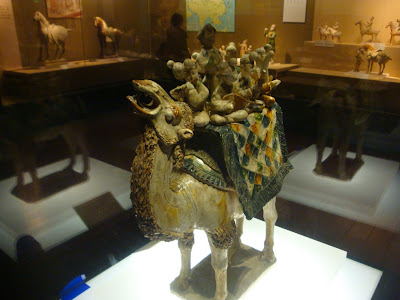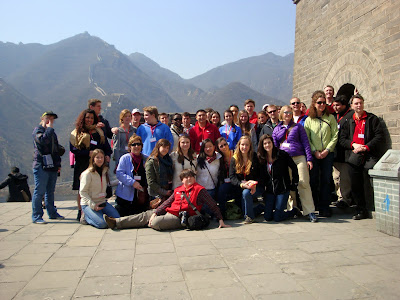Today, after being teased yesterday by the Shanxi Provincial Museum, we were finally going to see the Terra-cotta Warriors. The Terra-cotta Warriors. The ones you learned about in 5th grade and then sort of forgot about... yup, those ones. Some of us may
be a little rusty on the history of these warriors so let me try to polish it up for you...
Pretty much, The first emperor of China – Mr. Qin Shi Huang – had an epic tomb for himself built. Very similar to the pyramids in Egypt, except his tomb was for the most part
underground. In fact, the meaning of Terra-cotta is "made by earth". The emperor had many defenses set up in his tomb, and one of the more larger ones were the Terra-cotta Warriors. Another impressive defense he set up was a moat of mercury surrounding the very center part, where his body actually laid with all of his treasures. This moat of mercury is still keeping archeologists out of his tomb T
ODAY. They have read about the moat in ancient records, so they know it is there. But they do not know how much is there... so if they do uncover this moat, an unknown amount of deadly mercury would evaporate into the air. They also do not know how he obtained so much mercury, and how he managed to get it to that specific sport. It is to this day a mystery how he constructed such
a defense. I guess, it's like the same way Stonehenge was built....... aliens helped.
***
To help build the suspense, they first took us to a small shop in Xi'an where they make replicas of the Terra-cotta Warriors for people to own. They showed us the impressive system of first, rolling out the clay...

...and then putting it into a mold, adding design features... and finally you get something that starts to look like this:


After spending a little more time there we finally headed off the place. The top dog. No replicas this time, the real deal. After getting past a parking lot you would expect to see at a small theme park, you see this dude:

The year was 1974 when an average farmer began to dig a well... after digging a few feet down, he discovered some pottery fragments.... Now today, we have an airplane hanger of an artifact. They first presumed there to be about 100 warriors covering an area
of about 50 meters. But they kept finding them, and now today they presume there to be over 8,000.


The warriors were constructed hollow, so they were actually in a wreck when the archeologists found them. Any fully in-tact warrior you see today has been placed back together by the archeologists, piece by piece. They leave some in ruins, for a reference.

In the very top right hand corner, you are able to see where the well was dug. Looking at its location, it's amazing to think that if he had dug the well just a little more forward, he would have never discovered the warriors.




Closer to the back, you can see where archeologists continue to try and piece back together the warriors.

Also in the middle section, you can observe archeologists still uncovering warriors! It makes you realize that this tourist attraction is still under a lot of work.

The emperor did not have a secret way for the workers to get out of the tomb after they built it. Instead, he had 720,000 workers buried alive with him. Nice guy...

In another building there was what looked like just waves of dirt. It turns out, when the archeologists discovered the warriors, they were painted with bright vibrant colors! But because of the sudden exposure the the sunlight and air, these colors vanished within minutes. So underneath these waves of dirt are warriors... but they do not what to dig them up until they have technology to preserve these colors. So for now, they sit here as "discovered yet undiscovered" wonders.


After several hours of taking in this amazing exhibit, we headed off to the Xi'an airport for a flight to Ningbo, where Justin's school is located. For those of you who missed the details about Justin... he is a friend of Kris Johnson who teaches english at a high school in the city of Ningbo, China.



































